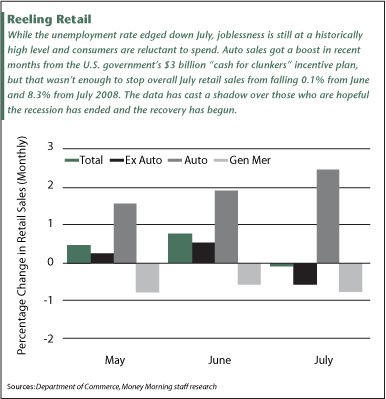The much-anticipated earnings report from Wal-Mart Stores Inc. (NYSE: WMT) and new data from the U.S. Department of Commerce yesterday (Thursday) showed that consumers are not only reeling in their discretionary spending, but may also be pulling the reins on the necessities.
Retail sales fell 0.1% in July from the previous month, and 8.3% from a year ago, the Labor Department said. Excluding auto sales, the sales declined 0.6%. A Bloomberg News poll of 76 economists projected sales including autos to rise 0.8%.
Grocery stores, where consumers find many necessities, saw their sales decline to $43.74 billion in July, down 1.4% from June's $43.87 billion.
The drop in sale reflects the still-shaky sentiment of consumers.
"Until we start seeing job growth, consumers are still going to be very cautious," Michael Gregory, a senior economist at BMO Capital Markets told Bloomberg. "It's premature to talk about the sustainability of a recovery," he said, until there's "follow-through on the demand side."
Wal-Mart, the world's largest retailer, saw its sales drop 1.4% to $100.08 billion in the three months ended July 31. The company's profit fell to $3.44 billon from $3.45 billion a year ago. One of the reasons for the decline was a stronger dollar, which shaved about $4.2 billion off of the company's revenue. Excluding currency exchange rates, Wal-Mart's revenue actually climbed 2.7% to $104.28 billion.
However, a dearth of consumer confidence was also evident in the retail giant's overall same-store sales, which fell 1.2%. Wal-Mart had expected same store sales to remain flat or gain 3%. Only its Sam's Club discount stores held true to the estimate, showing an increase of 0.6%. Sales at Wal-Mart outlets fell 1.5%.
The gain at Sam's Club, where consumers pay $40 a year to buy everyday items like shampoo and toothpaste at bulk prices, shows how club stores offer a better value proposition than Wal-Mart's namesake outlets. For instance, a tri-color ink cartridge from Hewlett-Packard Company (NYSE: HPQ) that costs $39.97 at Wal-Mart sells for $33.84 at Sam's Club, a savings of nearly 16%.
"Our customers are more disciplined in their spending," Wal-Mart Chief Executive Officer Mike Duke said in a conference call with investors, adding that consumers are saving more and spending less.

The Reuters/University index of consumer sentiment dropped to 66 in July from 70.8 the month before, Bloomberg reported. The Conference Board's Consumer Confidence Index fell to 46.6 in July, down from June's 49.3.
With consumer confidence and spending waning, the coming months, particularly the October-December holiday shopping season, retail sales may see growth in Sam's Club and other warehouse stores like Costco Wholesale Corp. (Nasdaq: COST) and BJ's Wholesale Club (NYSE: BJ).
Same-store sales at Costco shrank 2% in July, while growing 5% at BJ's. Costco blamed the decrease on less discretionary spending but noted its strongest categories included food and fresh food products, including deli, candy and frozen food items. BJ's reported gains in similar categories.
News and Related Story Links:
-
U.S. Department of Commerce:
Advance Monthly Sales for Retail Trade and Food Services -
Bloomberg News:
U.S. Economy: Sales Unexpectedly Decrease As Job Losses Mount -
Wal-Mart:
Second Quarter Earnings -
Investopedia:
Value Proposition -
Bloomberg News:
U.S. Economy: Consumer Sentiment Falls on Job Concern


